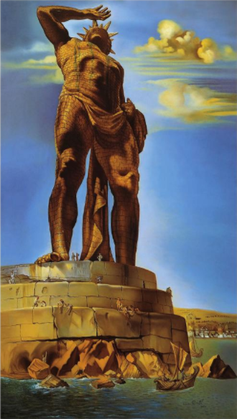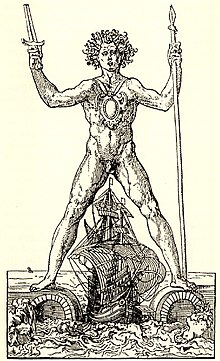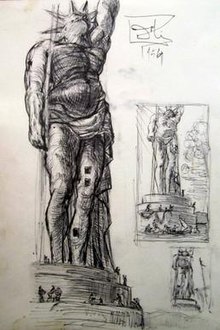The Colossus of Rhodes (Dalí)
| The Colossus of Rhodes | |
|---|---|
| El Coloso de Rodas, Le Colosse de Rhodes | |
 | |
| Artist | Salvador Dalí |
| Year | 1954 |
| Medium | Oil on canvas |
| Dimensions | 68.8 cm × 39 cm (27.1 in × 15.4 in) |
| Location | Kunstmuseum Bern |
| Accession | G 82.007 |
The Colossus of Rhodes is a 1954 oil painting by the Spanish surrealist artist Salvador Dalí. It is one of a series of seven paintings created for the 1956 film Seven Wonders of the World, each depicting one of the eponymous wonders. The painting shows the Colossus of Rhodes, the ancient statue of the Greek titan-god of the sun, Helios. It was ultimately not used for the movie, and in 1981 was donated to the Kunstmuseum Bern, its present location.
Painted two decades after Dalí's heyday with the surrealist movement, The Colossus of Rhodes is emblematic of his shift from the avant-garde to the mainstream. After financial pressures imposed by his move to the United States in 1940, and influenced by his fascination with Hollywood, Dalí shifted focus away from his earlier exploration of the subconscious and perception, and towards historical and scientific themes.
Dalí's rendering of the Colossus is heavily influenced by a 1953 paper by Herbert Maryon, a sculptor and conservator at the British Museum. Maryon proposed a hollow Colossus formed from hammered bronze plates, located alongside the harbour rather than astride it. He further suggested that it used a hanging drapery to give the statue a stable tripod base. These elements were all incorporated by Dalí.
Background
The Colossus

The Colossus of Rhodes was a monumental statue of the Greek sun god, Helios, that stood by the harbour of Rhodes for more than half a century in the third century BC.[1] According to first-century BC historian Diodorus Siculus, it was constructed under the direction of Chares of Lindos to commemorate the city's victory over Demetrius Poliorcetes, who laid siege to Rhodes from 305 to 304 BC; Helios, patron saint of both the city and island of Rhodes, was chosen as the honoree.[2] The statue stood until the 226 BC Rhodes earthquake, when, according to Pliny the Elder, three centuries later in his Naturalis Historia, it buckled and fell.[3] In his ninth-century AD Chronographia, Theophanes the Confessor wrote that its ruins remained until 652–53, when Muawiyah I conquered Rhodes, and the Colossus was sold for scrap.[4] Beginning with lists formed by Diodorus and other writers, the Colossus is recognized as one of the Seven Wonders of the Ancient World.[5]
There are no extant contemporary depictions of the Colossus; the only evidence is textual, much of it summary and postdating the statue by centuries.[6] Imagination has frequently filled in for documentation.[7] Scientific attempts to re-envision the Colossus have persisted since the eighteenth century.[8] In a presentation delivered in 1953, Herbert Maryon suggesting that the statue was hollow, and stood aside the harbour rather than astride it.[9][10][11][12] Made of hammered bronze plates less than 1⁄16-inch (1.6 mm) thick, Maryon said that the Colossus would have been supported on its base by a third point of support in the form of hanging drapery.[13][14] Although Maryon's theory was not published until 1956,[15] two years after Dalí's painting, newspaper articles about Maryon's 1953 presentation proliferated quickly and internationally, and his theory heavily influenced Dalí.[14][16]
Dalí and Hollywood
The Colossus of Rhodes came from of Dalí's longstanding fascination with Hollywood.[17] He viewed the industry as a surrealist medium, and described Walt Disney, Cecil B. DeMille and the Marx Brothers as "the three great American Surrealists". In his 1937 essay Surrealism in Hollywood, he wrote that "Nothing seems to me more suited to be devoured by the surrealist fire than those mysterious strips of 'hallucinatory celluloid' turned out so unconsciously in Hollywood, and in which we have already seen appear, stupefied, so many images of authentic delirium, chance and dream."[18]
For the 1956 Cinerama film Seven Wonders of the World, a travelogue featuring Lowell Thomas, Dalí was commissioned to create seven paintings of the wonders. Several were completed in 1954: The Colossus of Rhodes,[19] The Pyramids,[20][21][note 1] The Statue of Olympian Zeus,[22] The Temple of Diana at Ephesus,[23] The Walls of Babylon,[24] and two versions of the same wonder, The Lighthouse of Alexandria[25] and Lighthouse of Alexandria.[26][27][28] In 1955 he produced a further version of The Walls of Babylon,[29] and painted the last wonder, The Mausoleum at Halicarnassus.[27][note 2] The paintings were ultimately not used for the film.[30]
Description
The painting shows the Colossus of Rhodes standing on a base of unworked ashlar.[31] The perspective is from below the statue's base, suggesting that the viewer is on a boat approaching the city, and emphasising the statue's extreme height and size.[32] A piece of drapery wraps around the waist of Helios and hangs from his left arm, falling down to touch the ground behind him.[14] The statue appears to be made of bronze, and has a segmented construction entirely composed of numerous individual plates.[14][33] Helios raises his right hand to shield his eyes from the sun over which he reigns, giving what the art historian Eric Shanes terms "a vaguely Surrealist touch" to Dalí's work.[32] In the lower right Dalí signed and dated the work "Salvador Dalí / 1954".[19]
Themes
Dalí's most recognised works date from before 1940, when he was preoccupied with the subconscious and the nature of perception.[34] The Persistence of Memory, the work with which he is most identified, was painted in 1931,[35] and represented a decade that saw Dalí firmly within the avant-garde.[36] His move to the United States in 1940 caused financial pressures, but brought to the fore his flair for showmanship, helping to develop his relationship with Hollywood.[37] At the end of World War II, a focus on the historical, scientific, and religious was introduced into Dalí's work.[37]
The Colossus of Rhodes exemplifies Dalí's preoccupations with cinema, history, and science, and his loosening grip on surrealism.[32] It is only marginally surrealist—the god of the sun shields himself from his domain—and resembles a poster,[32] befitting a work commissioned for a movie.[27] Nor does Dalí offer a particularly original take on the Colossus, which is heavily influenced by Maryon's suggestions.[14] Compared with Maryon's paper, writes the scholar Godefroid de Callataÿ, the painting "does not look extremely original".[14] Dalí copied the likeness of the Colossus put forth by Maryon, clearly depicting hammered plates of bronze, and showing the same tripod structure of a figure supported by a piece of drapery.[14]
Provenance
The painting is in the collection of the Kunstmuseum Bern, as part of the 1981 Georges F. Keller bequest.[19] It was exhibited at the Museo de Arte Moderno in Madrid during 1983, at the Staatsgalerie Stuttgart in Stuttgart in 1989, at the Louisiana Museum of Modern Art in Humlebaek from 1989 to 1990, and later in 1990 in Montréal, at the Musée des Beaux-Arts.[19]
Several of the other paintings in the Seven Wonders of the World series have come up for sale. The Statue of Olympian Zeus was sold by Sotheby's in 2009 for $482,500,[38] and is now in the collection of the Morohashi Museum of Modern Art.[22] In 2013 Sotheby's sold The Temple of Diana at Ephesus for $845,000;[39] it is now in a private collection.[23] The Walls of Babylon was offered by Sotheby's in 2014 with an estimate of £300,000–400,000, but was bought in.[28] Dalí's thematically similar 1955 paintings have been auctioned. Christie's sold The Mausoleum at Halicarnassus for $1,325,000 in 2016,[27] and Walls of Babylon in 2001 for £168,750.[40]
Versions

Dalí created at least one preparatory study, First Version of The Colossus of Rhodes,[41] a 1954 ink-on-cardboard work measuring 25 by 35.3 cm (9.8 by 13.9 in) that includes three sketches of the Colossus.[41] It was displayed from 3 November 2010 to 30 April 2011 at the Time Warner Center in New York, as part of the exhibition Dalí at Time Warner Center: The Vision of a Genius, where it was also for sale.[42]
Lithographs replicating the statue are frequently offered for sale.[43] Owing to what Shanes calls Dalí's "exploitative and/or lackadaisical attitude", the trade in Dalí's lithographs is "in chaos".[44] Dalí, eschewing the custom of limited printings with plates that were then destroyed, signed some 40,000 to 350,000 blank sheets of paper, which were then printed with his works.[45] Coupled with rampant forgeries of an easily faked signature, this—termed by Shanes "one of the largest and most prolonged acts of financial fraud ever perpetrated in the history of art"—caused the lithographs to become virtually worthless.[46]
Notes
- ^ The Gala-Salvador Dalí Foundation catalogue raisonné and the Fundación AMYC, which holds the work, list The Pyramids as a 1957 work.[20][21]
- ^ The Gala-Salvador Dalí Foundation catalogue raisonné does not list The Mausoleum at Halicarnassus. It sold in 2016 for $1,325,000 at Christie's, which led off its description by asserting that "Nicolas and the late Robert Descharnes have confirmed the authenticity of this work."[27]
References
- ^ de Callataÿ 2006, pp. 42–44.
- ^ de Callataÿ 2006, pp. 42–43.
- ^ de Callataÿ 2006, pp. 43–44.
- ^ de Callataÿ 2006, p. 44.
- ^ Maryon 1956, p. 68.
- ^ de Callataÿ 2006, pp. 40–41.
- ^ de Callataÿ 2006, pp. 47–48.
- ^ de Callataÿ 2006, p. 51.
- ^ Maryon 1956, pp. 72–75, 79–81.
- ^ de Callataÿ 2006, pp. 53–54.
- ^ Easby, Jr. 1966.
- ^ Maryon 1947.
- ^ Maryon 1956, pp. 72–75.
- ^ a b c d e f g de Callataÿ 2006, p. 54.
- ^ Maryon 1956.
- ^ Badoud 2012, pp. 34–36, 36 n.129.
- ^ King 2007, pp. 59–60.
- ^ King 2007, p. 59.
- ^ a b c d Catalogue Raisonné 689.
- ^ a b Catalogue Raisonné 693.
- ^ a b Arte Moderno y Contemporáneano.
- ^ a b Catalogue Raisonné 695.
- ^ a b Catalogue Raisonné 1149.
- ^ Catalogue Raisonné 692.
- ^ Catalogue Raisonné 690.
- ^ Catalogue Raisonné 691.
- ^ a b c d e Christie's 2016.
- ^ a b Sotheby's 2014.
- ^ Catalogue Raisonné 1148.
- ^ King 2007, p. 60.
- ^ Beristain & Descharnes 1983, p. 205.
- ^ a b c d Shanes 2012, pp. 224–225.
- ^ Badoud 2012, pp. 34–36.
- ^ Shanes 2012, pp. 47–48.
- ^ Shanes 2012, pp. 35–36.
- ^ Shanes 2012, pp. 53, 57.
- ^ a b Shanes 2012, pp. 48–53.
- ^ Sotheby's 2009.
- ^ Sotheby's 2013.
- ^ Christie's 2001.
- ^ a b Sabater y Bonany 2010, p. 31.
- ^ Sabater y Bonany 2010, pp. 1, 31.
- ^ Los Angeles Times 1985.
- ^ Shanes 2012, p. 57.
- ^ Shanes 2012, pp. 54–57.
- ^ Shanes 2012, pp. 48, 54–57.
Bibliography
- Badoud, Nathan (January 2012). "L'image du Colosse de Rhodes". Monuments et Mémoires de la Fondation Eugène Piot (in French). 91: 5–40. doi:10.3406/piot.2012.1738.
{{cite journal}}: Invalid|ref=harv(help)
- Beristain, Ana; Descharnes, Robert (1983). 400 Obras de Salvador Dalí de 1914 a 1983: Exposición Realizada Conjuntamente por el Ministerio de Cultura y la Generalitat de Catalunya en homenaje a Salvador Dalí (in Spanish). Madrid: Ministerio de Cultura. ISBN 84-500-8720-1.
{{cite book}}: Invalid|ref=harv(help); Unknown parameter|lastauthoramp=ignored (|name-list-style=suggested) (help) - "The Colossus of Rhodes". Catalogue Raisonné of Paintings by Salvador Dalí. Gala-Salvador Dalí Foundation. Retrieved 13 January 2018.

- de Callataÿ, Godefroid (2006). "The Colossus of Rhodes: Ancient Texts and Modern Representations". In Ligota, Christopher R.; Quantin, Jean-Louis (eds.). History of Scholarship: A Selection of Papers from the Seminar on the History of Scholarship Held Annually at the Warburg Institute. London: Oxford University Press. pp. 39–73. ISBN 978-0-19-928431-3.
{{cite book}}: Invalid|ref=harv(help); Unknown parameter|lastauthoramp=ignored (|name-list-style=suggested) (help)
- Easby, Jr., Dudley T. (July 1966). "Necrology". American Journal of Archaeology. 70 (3). Archaeological Institute of America: 287. JSTOR 501899.
{{cite journal}}: Invalid|ref=harv(help)
- "Fine Works Featured in Auction Scheduled at Capital Fine Art". Advertising Supplement. Los Angeles Times. Los Angeles, California. 12 April 1985. p. 2 – via Newspapers.com.

- King, Elliot H. (2007). Dalí, Surrealism and Cinema. Harpenden: Kamera Books. ISBN 978-1-904048-90-9.
{{cite book}}: Invalid|ref=harv(help)
- "The Lighthouse of Alexandria". Catalogue Raisonné of Paintings by Salvador Dalí. Gala-Salvador Dalí Foundation. Retrieved 14 January 2018.

- "Lighthouse of Alexandria". Catalogue Raisonné of Paintings by Salvador Dalí. Gala-Salvador Dalí Foundation. Retrieved 14 January 2018.

- Maryon, Herbert (September 1947). "The Sutton Hoo Helmet". Antiquity. XXI (83): 137–144. doi:10.1017/S0003598X00016598.
{{cite journal}}: Invalid|ref=harv(help)
- Maryon, Herbert (1956). "The Colossus of Rhodes". The Journal of Hellenic Studies. LXXVI: 68–86. doi:10.2307/629554. JSTOR 629554.
{{cite journal}}: Invalid|ref=harv(help)
- "The Pyramids". Catalogue Raisonné of Paintings by Salvador Dalí. Gala-Salvador Dalí Foundation. Retrieved 14 January 2018.

- Sabater y Bonany, Enrique (2010). Dalí at Time Warner Center: The Vision of a Genius. New York: Galerie Elysses. OCLC 794730258.
{{cite book}}: Invalid|ref=harv(help) - "Salvador Dali (1904–1989): Le mausolée d'Halicarnasse". Christie's. 2016. Retrieved 13 January 2018.

- "Salvador Dali (1904–1989): The Walls of Babylon". Christie's. 2001. Retrieved 14 January 2018.

- "Salvador Dalí: Les Murs de Babylone". Sotheby's. 2014. Retrieved 13 January 2018.

- "Salvador Dalí: Giza Pyramids 1957". Fundación AMYC. Retrieved 8 March 2019.

- "Salvador Dalí: Statue de Zeus Olympien". Sotheby's. 2009. Retrieved 14 January 2018.

- "Salvador Dalí: Temple de Diana à Epheseus". Sotheby's. 2013. Retrieved 14 January 2018.

- Shanes, Eric (2012). The Life and Masterworks of Salvador Dalí. New York: Parkstone International. ISBN 978-1-78042-879-6.
{{cite book}}: Invalid|ref=harv(help)
- "The Statue of Olympian Zeus". Catalogue Raisonné of Paintings by Salvador Dalí. Gala-Salvador Dalí Foundation. Retrieved 14 January 2018.

- "The Temple of Diana at Ephesus". Catalogue Raisonné of Paintings by Salvador Dalí. Gala-Salvador Dalí Foundation. Retrieved 14 January 2018.

- "The Walls of Babylon". Catalogue Raisonné of Paintings by Salvador Dalí. Gala-Salvador Dalí Foundation. Retrieved 14 January 2018.

- "Walls of Babylon". Catalogue Raisonné of Paintings by Salvador Dalí. Gala-Salvador Dalí Foundation. Retrieved 14 January 2018.

